lock MAZDA MODEL 3 HATCHBACK 2008 (in English) Workshop Manual
[x] Cancel search | Manufacturer: MAZDA, Model Year: 2008, Model line: MODEL 3 HATCHBACK, Model: MAZDA MODEL 3 HATCHBACK 2008Pages: 394, PDF Size: 5.68 MB
Page 103 of 394
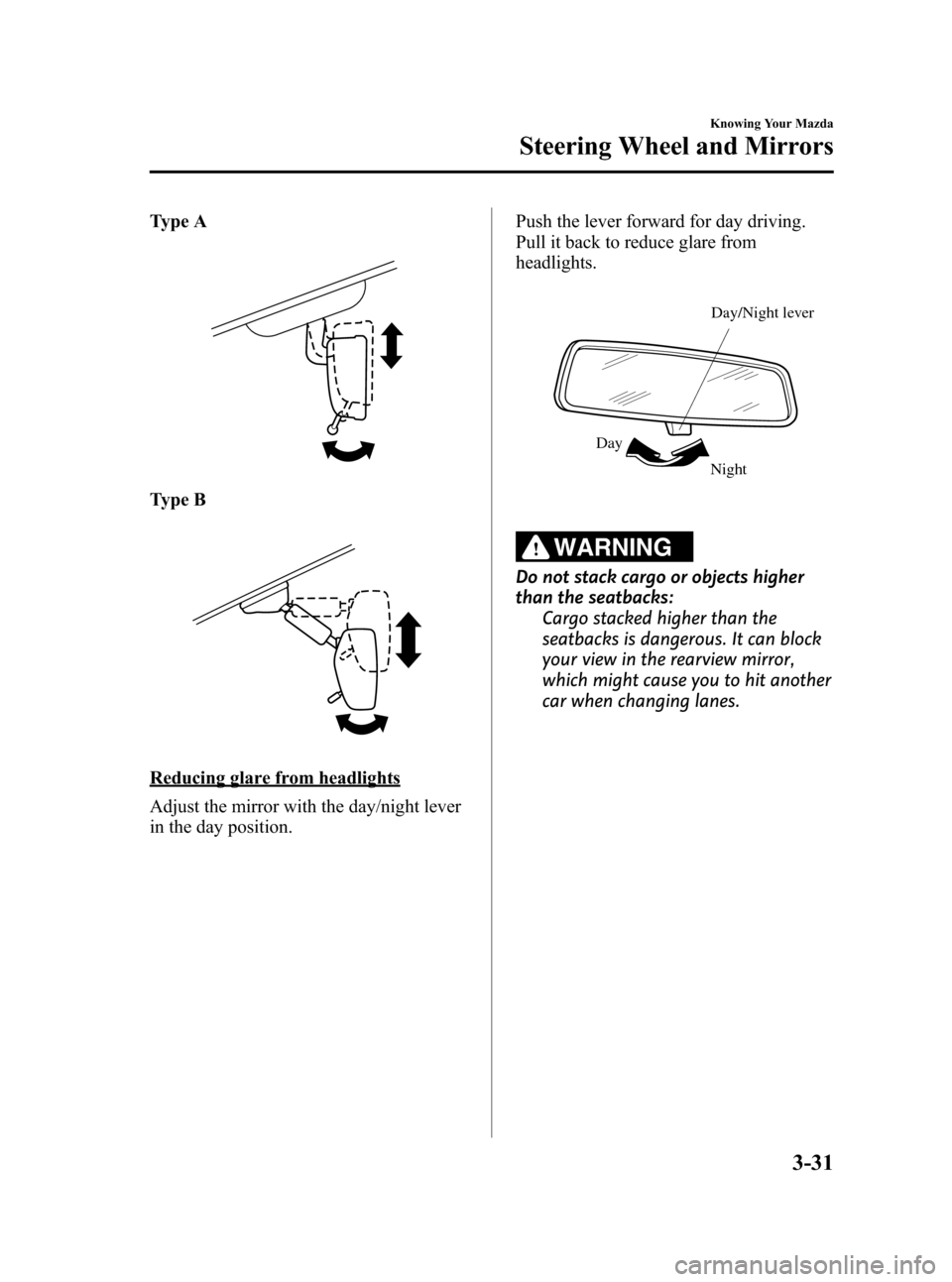
Black plate (103,1)
Type A
Type B
Reducing glare from headlights
Adjust the mirror with the day/night lever
in the day position.Push the lever forward for day driving.
Pull it back to reduce glare from
headlights.
Night DayDay/Night lever
WARNING
Do not stack cargo or objects higher
than the seatbacks:
Cargo stacked higher than the
seatbacks is dangerous. It can block
your view in the rearview mirror,
which might cause you to hit another
car when changing lanes.
Knowing Your Mazda
Steering Wheel and Mirrors
3-31
Mazda3_8X41-EA-07F_Edition2 Page103
Monday, June 18 2007 1:28 PM
Form No.8X41-EA-07F
Page 109 of 394
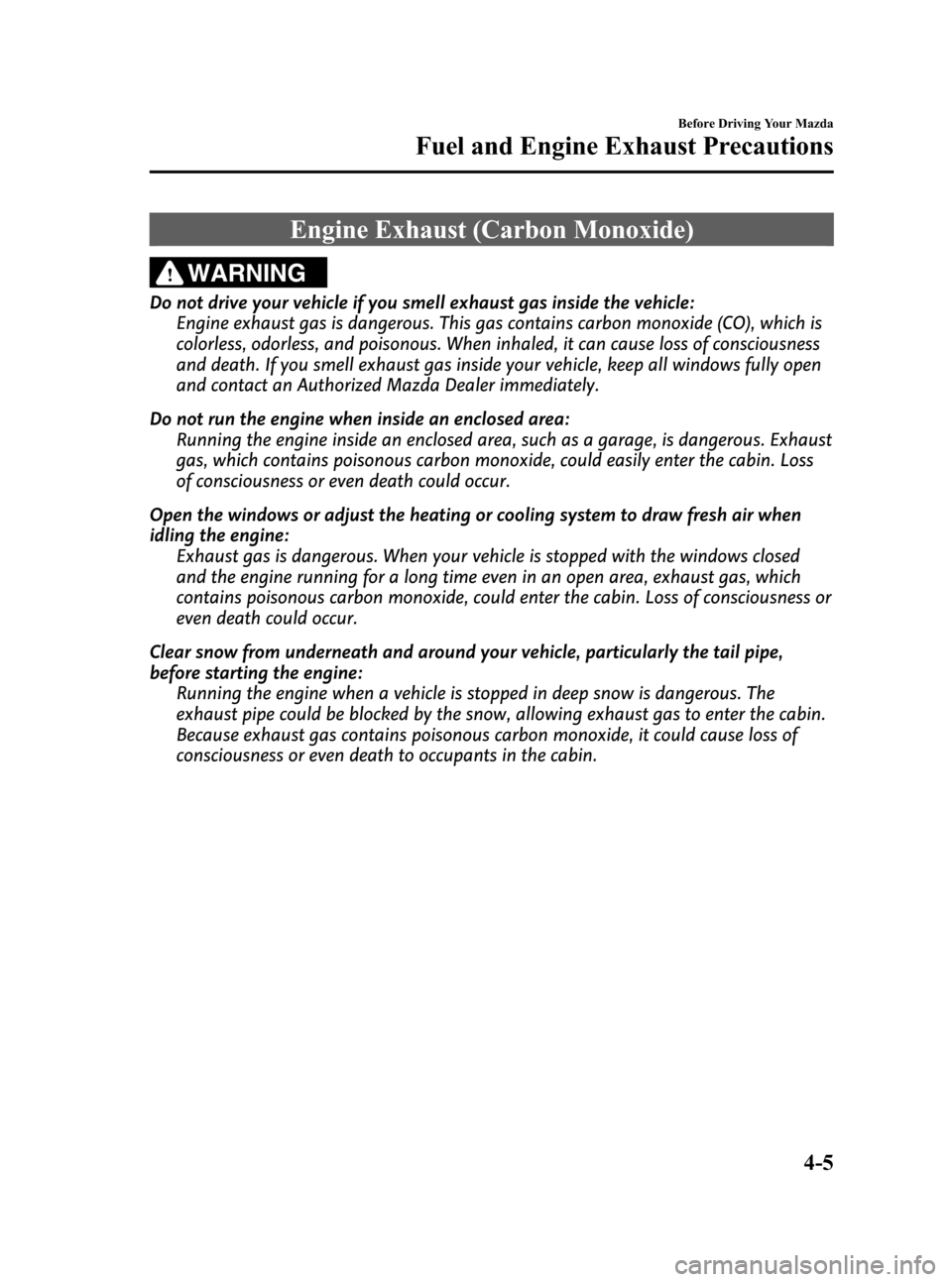
Black plate (109,1)
Engine Exhaust (Carbon Monoxide)
WARNING
Do not drive your vehicle if you smell exhaust gas inside the vehicle:
Engine exhaust gas is dangerous. This gas contains carbon monoxide (CO), which is
colorless, odorless, and poisonous. When inhaled, it can cause loss of consciousness
and death. If you smell exhaust gas inside your vehicle, keep all windows fully open
and contact an Authorized Mazda Dealer immediately.
Do not run the engine when inside an enclosed area:
Running the engine inside an enclosed area, such as a garage, is dangerous. Exhaust
gas, which contains poisonous carbon monoxide, could easily enter the cabin. Loss
of consciousness or even death could occur.
Open the windows or adjust the heating or cooling system to draw fresh air when
idling the engine:
Exhaust gas is dangerous. When your vehicle is stopped with the windows closed
and the engine running for a long time even in an open area, exhaust gas, which
contains poisonous carbon monoxide, could enter the cabin. Loss of consciousness or
even death could occur.
Clear snow from underneath and around your vehicle, particularly the tail pipe,
before starting the engine:
Running the engine when a vehicle is stopped in deep snow is dangerous. The
exhaust pipe could be blocked by the snow, allowing exhaust gas to enter the cabin.
Because exhaust gas contains poisonous carbon monoxide, it could cause loss of
consciousness or even death to occupants in the cabin.
Before Driving Your Mazda
Fuel and Engine Exhaust Precautions
4-5
Mazda3_8X41-EA-07F_Edition2 Page109
Monday, June 18 2007 1:28 PM
Form No.8X41-EA-07F
Page 110 of 394
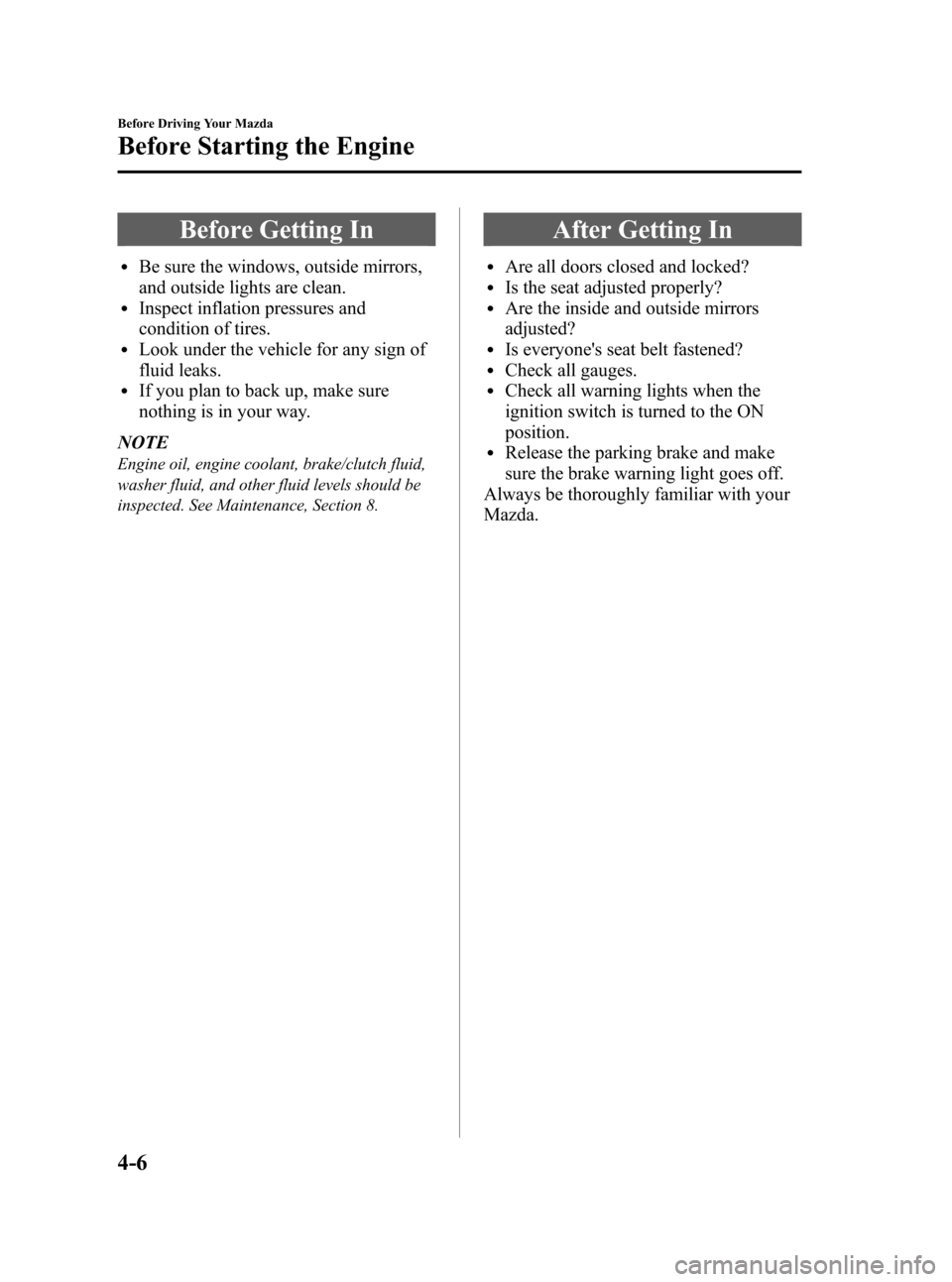
Black plate (110,1)
Before Getting In
lBe sure the windows, outside mirrors,
and outside lights are clean.
lInspect inflation pressures and
condition of tires.
lLook under the vehicle for any sign of
fluid leaks.
lIf you plan to back up, make sure
nothing is in your way.
NOTE
Engine oil, engine coolant, brake/clutch fluid,
washer fluid, and other fluid levels should be
inspected. See Maintenance, Section 8.
After Getting In
lAre all doors closed and locked?lIs the seat adjusted properly?lAre the inside and outside mirrors
adjusted?
lIs everyone's seat belt fastened?lCheck all gauges.lCheck all warning lights when the
ignition switch is turned to the ON
position.
lRelease the parking brake and make
sure the brake warning light goes off.
Always be thoroughly familiar with your
Mazda.
4-6
Before Driving Your Mazda
Before Starting the Engine
Mazda3_8X41-EA-07F_Edition2 Page110
Monday, June 18 2007 1:28 PM
Form No.8X41-EA-07F
Page 112 of 394
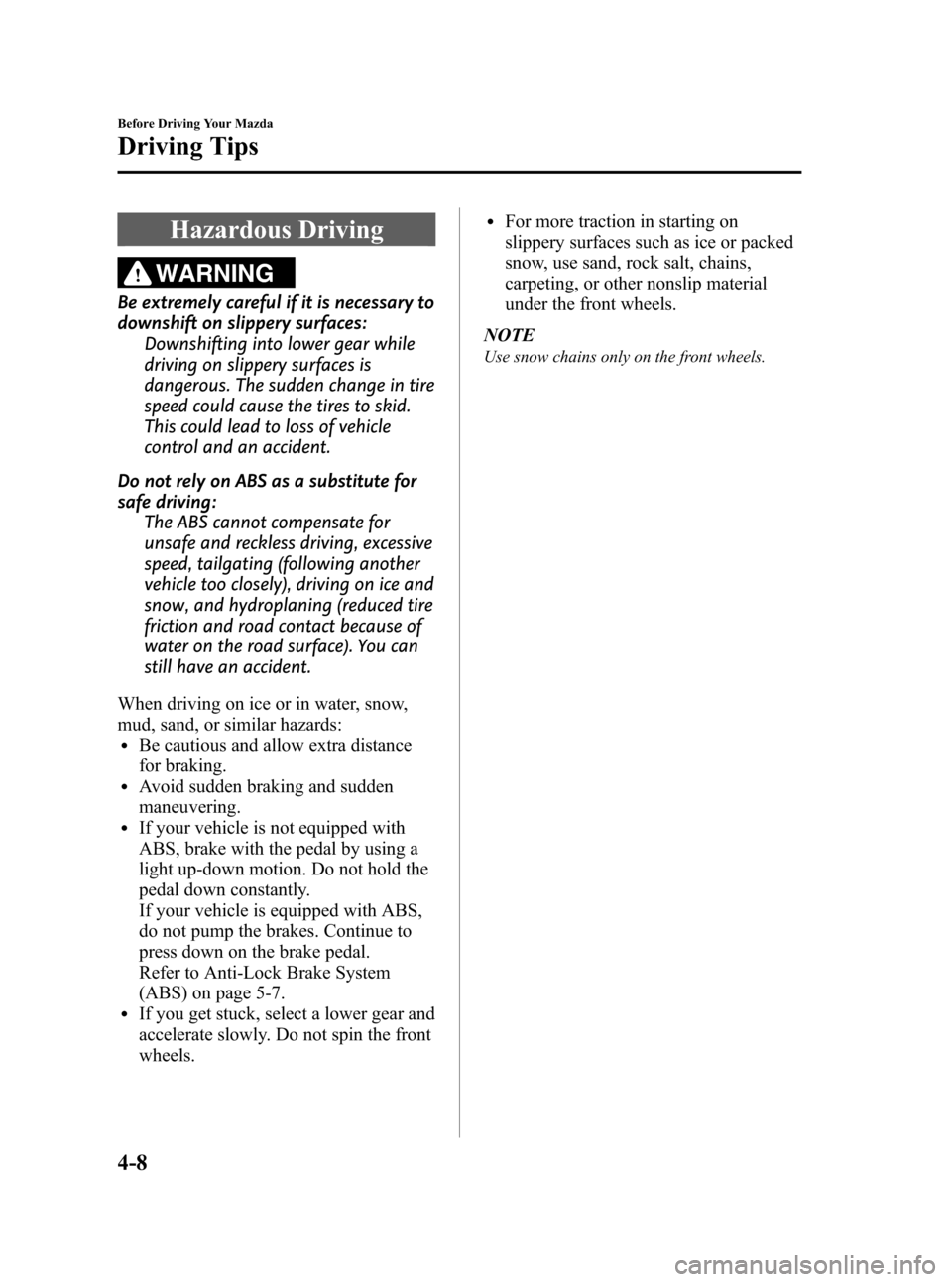
Black plate (112,1)
Hazardous Driving
WARNING
Be extremely careful if it is necessary to
downshift on slippery surfaces:
Downshifting into lower gear while
driving on slippery surfaces is
dangerous. The sudden change in tire
speed could cause the tires to skid.
This could lead to loss of vehicle
control and an accident.
Do not rely on ABS as a substitute for
safe driving:
The ABS cannot compensate for
unsafe and reckless driving, excessive
speed, tailgating (following another
vehicle too closely), driving on ice and
snow, and hydroplaning (reduced tire
friction and road contact because of
water on the road surface). You can
still have an accident.
When driving on ice or in water, snow,
mud, sand, or similar hazards:
lBe cautious and allow extra distance
for braking.
lAvoid sudden braking and sudden
maneuvering.
lIf your vehicle is not equipped with
ABS, brake with the pedal by using a
light up-down motion. Do not hold the
pedal down constantly.
If your vehicle is equipped with ABS,
do not pump the brakes. Continue to
press down on the brake pedal.
Refer to Anti-Lock Brake System
(ABS) on page 5-7.
lIf you get stuck, select a lower gear and
accelerate slowly. Do not spin the front
wheels.
lFor more traction in starting on
slippery surfaces such as ice or packed
snow, use sand, rock salt, chains,
carpeting, or other nonslip material
under the front wheels.
NOTE
Use snow chains only on the front wheels.
4-8
Before Driving Your Mazda
Driving Tips
Mazda3_8X41-EA-07F_Edition2 Page112
Monday, June 18 2007 1:28 PM
Form No.8X41-EA-07F
Page 113 of 394
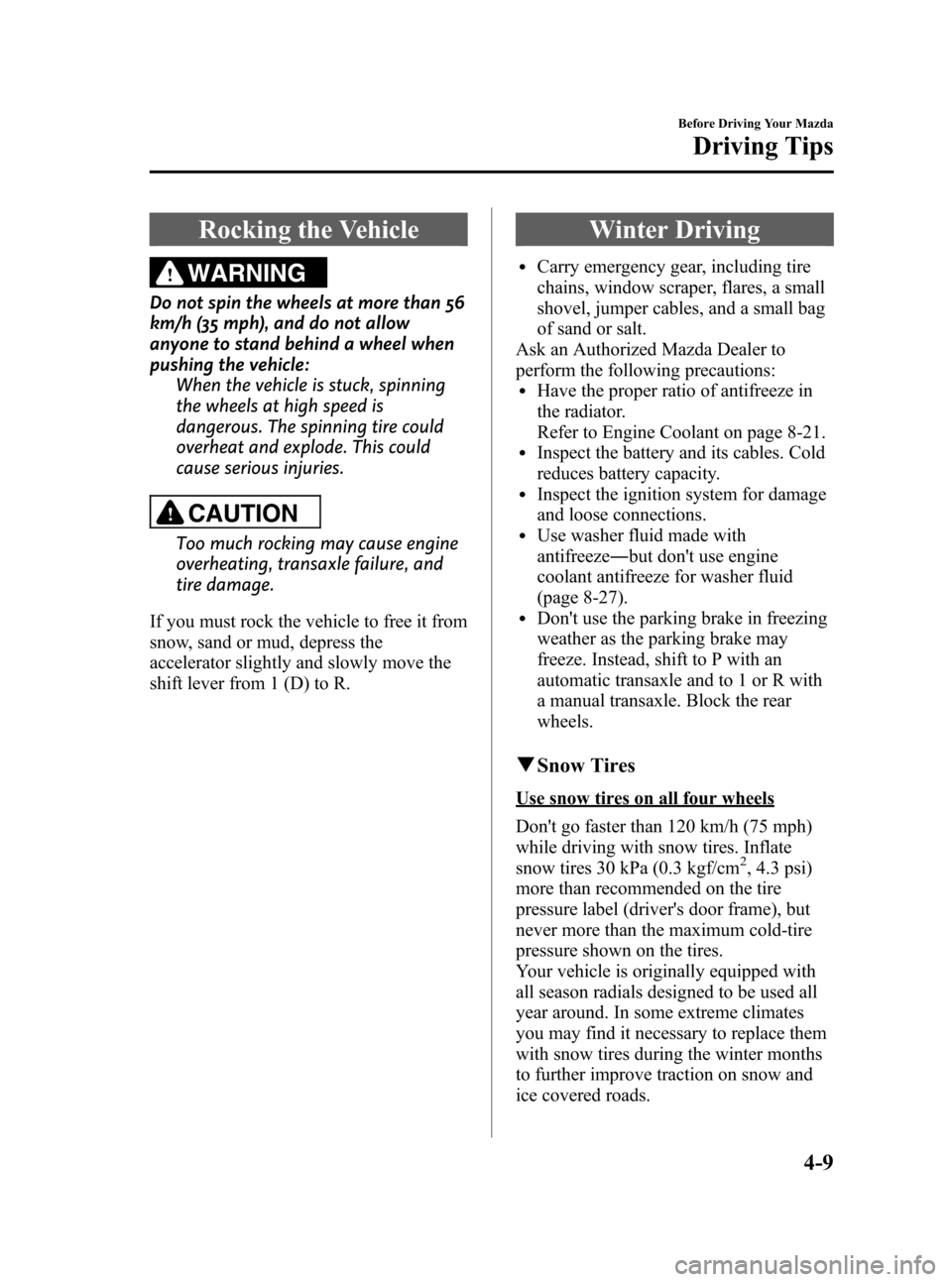
Black plate (113,1)
Rocking the Vehicle
WARNING
Do not spin the wheels at more than 56
km/h (35 mph), and do not allow
anyone to stand behind a wheel when
pushing the vehicle:
When the vehicle is stuck, spinning
the wheels at high speed is
dangerous. The spinning tire could
overheat and explode. This could
cause serious injuries.
CAUTION
Too much rocking may cause engine
overheating, transaxle failure, and
tire damage.
If you must rock the vehicle to free it from
snow, sand or mud, depress the
accelerator slightly and slowly move the
shift lever from 1 (D) to R.
Winter Driving
lCarry emergency gear, including tire
chains, window scraper, flares, a small
shovel, jumper cables, and a small bag
of sand or salt.
Ask an Authorized Mazda Dealer to
perform the following precautions:
lHave the proper ratio of antifreeze in
the radiator.
Refer to Engine Coolant on page 8-21.
lInspect the battery and its cables. Cold
reduces battery capacity.
lInspect the ignition system for damage
and loose connections.
lUse washer fluid made with
antifreeze―but don't use engine
coolant antifreeze for washer fluid
(page 8-27).
lDon't use the parking brake in freezing
weather as the parking brake may
freeze. Instead, shift to P with an
automatic transaxle and to 1 or R with
a manual transaxle. Block the rear
wheels.
qSnow Tires
Use snow tires on all four wheels
Don't go faster than 120 km/h (75 mph)
while driving with snow tires. Inflate
snow tires 30 kPa (0.3 kgf/cm
2, 4.3 psi)
more than recommended on the tire
pressure label (driver's door frame), but
never more than the maximum cold-tire
pressure shown on the tires.
Your vehicle is originally equipped with
all season radials designed to be used all
year around. In some extreme climates
you may find it necessary to replace them
with snow tires during the winter months
to further improve traction on snow and
ice covered roads.
Before Driving Your Mazda
Driving Tips
4-9
Mazda3_8X41-EA-07F_Edition2 Page113
Monday, June 18 2007 1:28 PM
Form No.8X41-EA-07F
Page 114 of 394
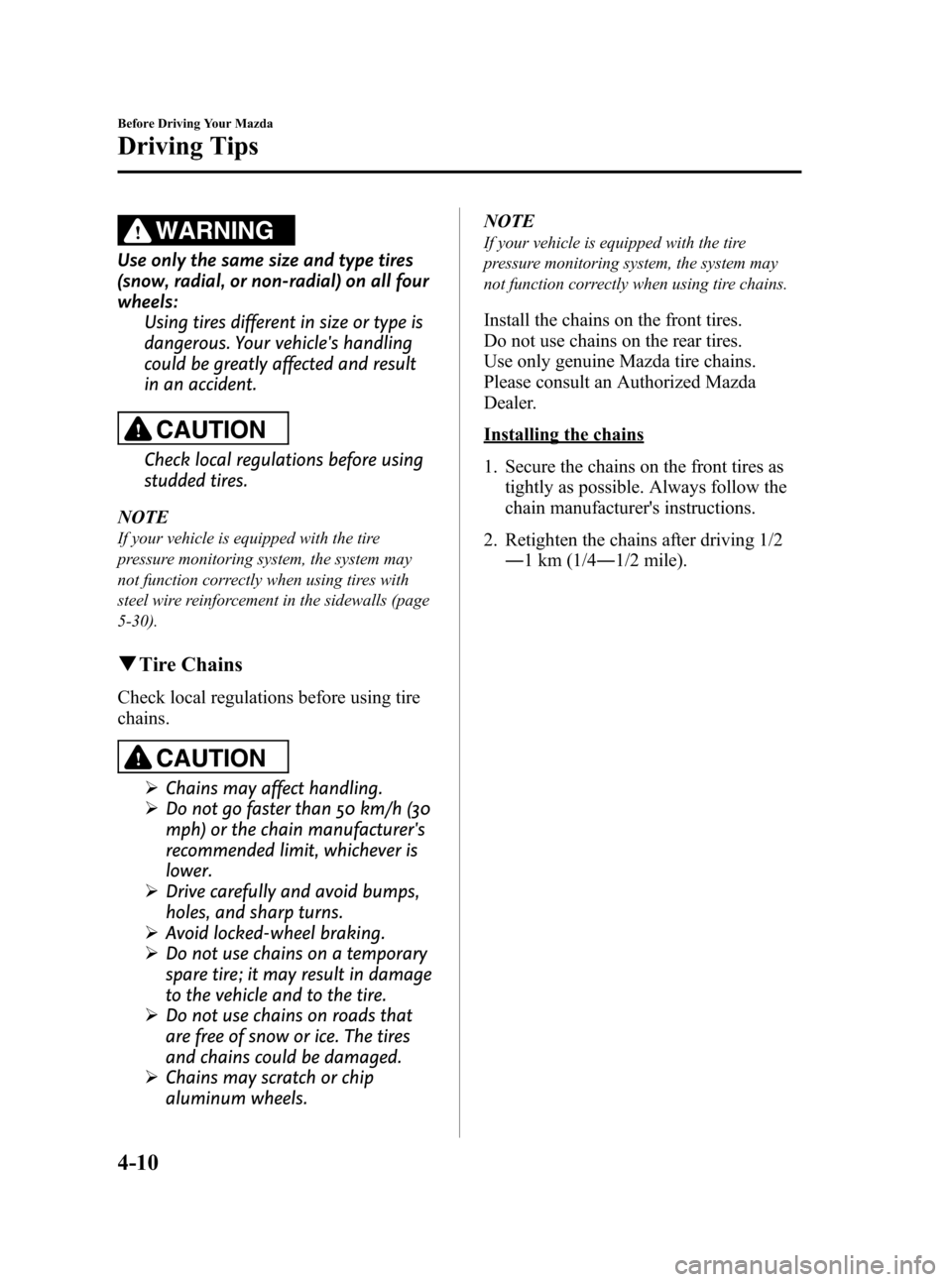
Black plate (114,1)
WARNING
Use only the same size and type tires
(snow, radial, or non-radial) on all four
wheels:
Using tires different in size or type is
dangerous. Your vehicle's handling
could be greatly affected and result
in an accident.
CAUTION
Check local regulations before using
studded tires.
NOTE
If your vehicle is equipped with the tire
pressure monitoring system, the system may
not function correctly when using tires with
steel wire reinforcement in the sidewalls (page
5-30).
qTire Chains
Check local regulations before using tire
chains.
CAUTION
ØChains may affect handling.
ØDo not go faster than 50 km/h (30
mph) or the chain manufacturer's
recommended limit, whichever is
lower.
ØDrive carefully and avoid bumps,
holes, and sharp turns.
ØAvoid locked-wheel braking.
ØDo not use chains on a temporary
spare tire; it may result in damage
to the vehicle and to the tire.
ØDo not use chains on roads that
are free of snow or ice. The tires
and chains could be damaged.
ØChains may scratch or chip
aluminum wheels.NOTE
If your vehicle is equipped with the tire
pressure monitoring system, the system may
not function correctly when using tire chains.
Install the chains on the front tires.
Do not use chains on the rear tires.
Use only genuine Mazda tire chains.
Please consult an Authorized Mazda
Dealer.
Installing the chains
1. Secure the chains on the front tires as
tightly as possible. Always follow the
chain manufacturer's instructions.
2. Retighten the chains after driving 1/2
―1 km (1/4―1/2 mile).
4-10
Before Driving Your Mazda
Driving Tips
Mazda3_8X41-EA-07F_Edition2 Page114
Monday, June 18 2007 1:28 PM
Form No.8X41-EA-07F
Page 120 of 394

Black plate (120,1)
Ignition Switch
qIgnition Switch Positions
LOCK
The steering wheel locks to protect
against theft. Only in this position can the
key be removed.
Manual transaxle
To turn the key from the ACC to the
LOCK position, push the button when the
key is at the ACC position, then turn the
key to the LOCK position.
Button
Push the
button
Automatic transaxle
To turn the key from the ACC to the
LOCK position, the shift lever must be in
the P position.
Shift lever
engaged in P
(park)
5-2
Driving Your Mazda
Starting and Driving
Mazda3_8X41-EA-07F_Edition2 Page120
Monday, June 18 2007 1:28 PM
Form No.8X41-EA-07F
Page 121 of 394
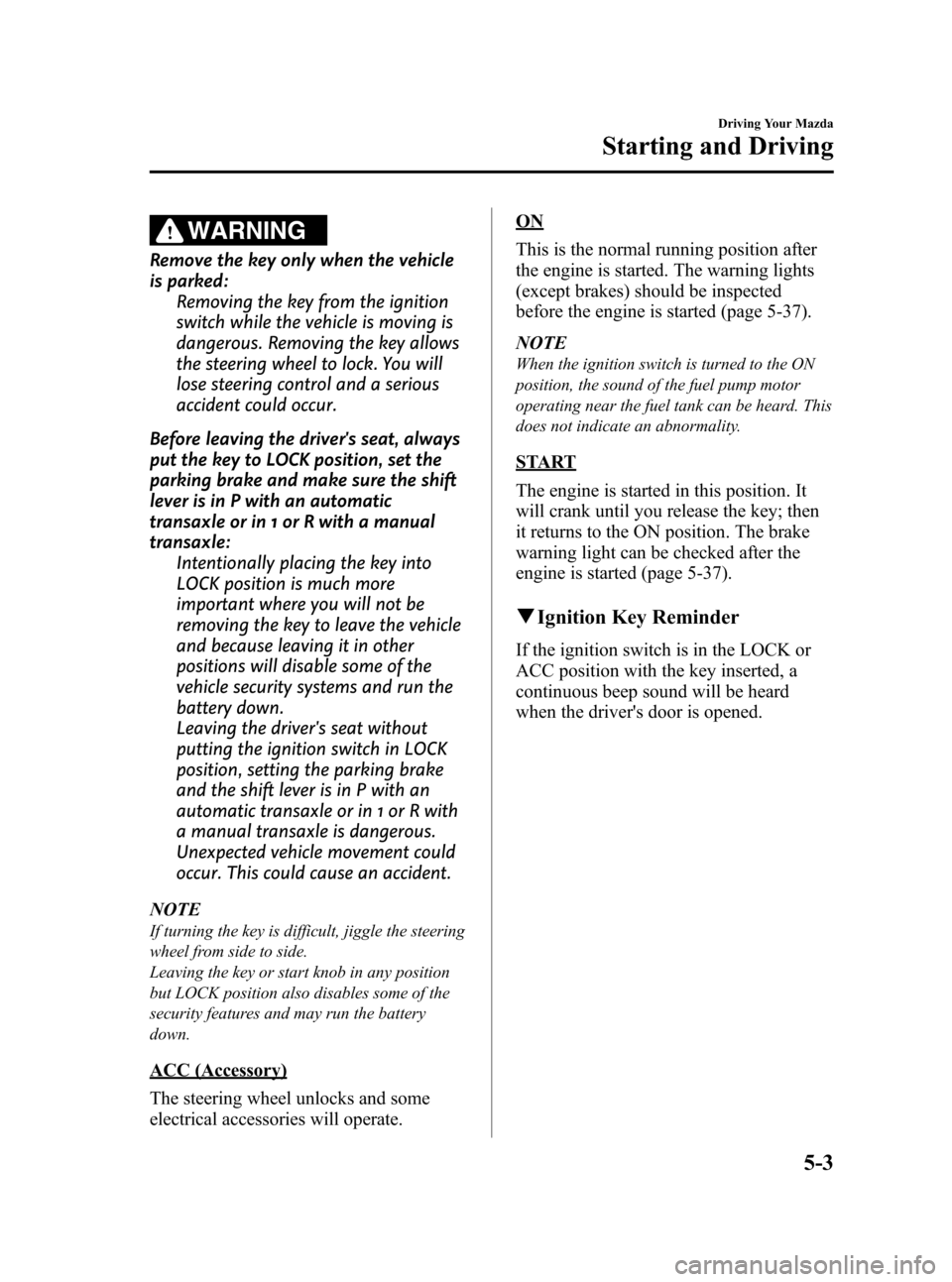
Black plate (121,1)
WARNING
Remove the key only when the vehicle
is parked:
Removing the key from the ignition
switch while the vehicle is moving is
dangerous. Removing the key allows
the steering wheel to lock. You will
lose steering control and a serious
accident could occur.
Before leaving the driver's seat, always
put the key to LOCK position, set the
parking brake and make sure the shift
lever is in P with an automatic
transaxle or in 1 or R with a manual
transaxle:
Intentionally placing the key into
LOCK position is much more
important where you will not be
removing the key to leave the vehicle
and because leaving it in other
positions will disable some of the
vehicle security systems and run the
battery down.
Leaving the driver's seat without
putting the ignition switch in LOCK
position, setting the parking brake
and the shift lever is in P with an
automatic transaxle or in 1 or R with
a manual transaxle is dangerous.
Unexpected vehicle movement could
occur. This could cause an accident.
NOTE
If turning the key is difficult, jiggle the steering
wheel from side to side.
Leaving the key or start knob in any position
but LOCK position also disables some of the
security features and may run the battery
down.
ACC (Accessory)
The steering wheel unlocks and some
electrical accessories will operate.
ON
This is the normal running position after
the engine is started. The warning lights
(except brakes) should be inspected
before the engine is started (page 5-37).
NOTE
When the ignition switch is turned to the ON
position, the sound of the fuel pump motor
operating near the fuel tank can be heard. This
does not indicate an abnormality.
START
The engine is started in this position. It
will crank until you release the key; then
it returns to the ON position. The brake
warning light can be checked after the
engine is started (page 5-37).
qIgnition Key Reminder
If the ignition switch is in the LOCK or
ACC position with the key inserted, a
continuous beep sound will be heard
when the driver's door is opened.
Driving Your Mazda
Starting and Driving
5-3
Mazda3_8X41-EA-07F_Edition2 Page121
Monday, June 18 2007 1:28 PM
Form No.8X41-EA-07F
Page 124 of 394
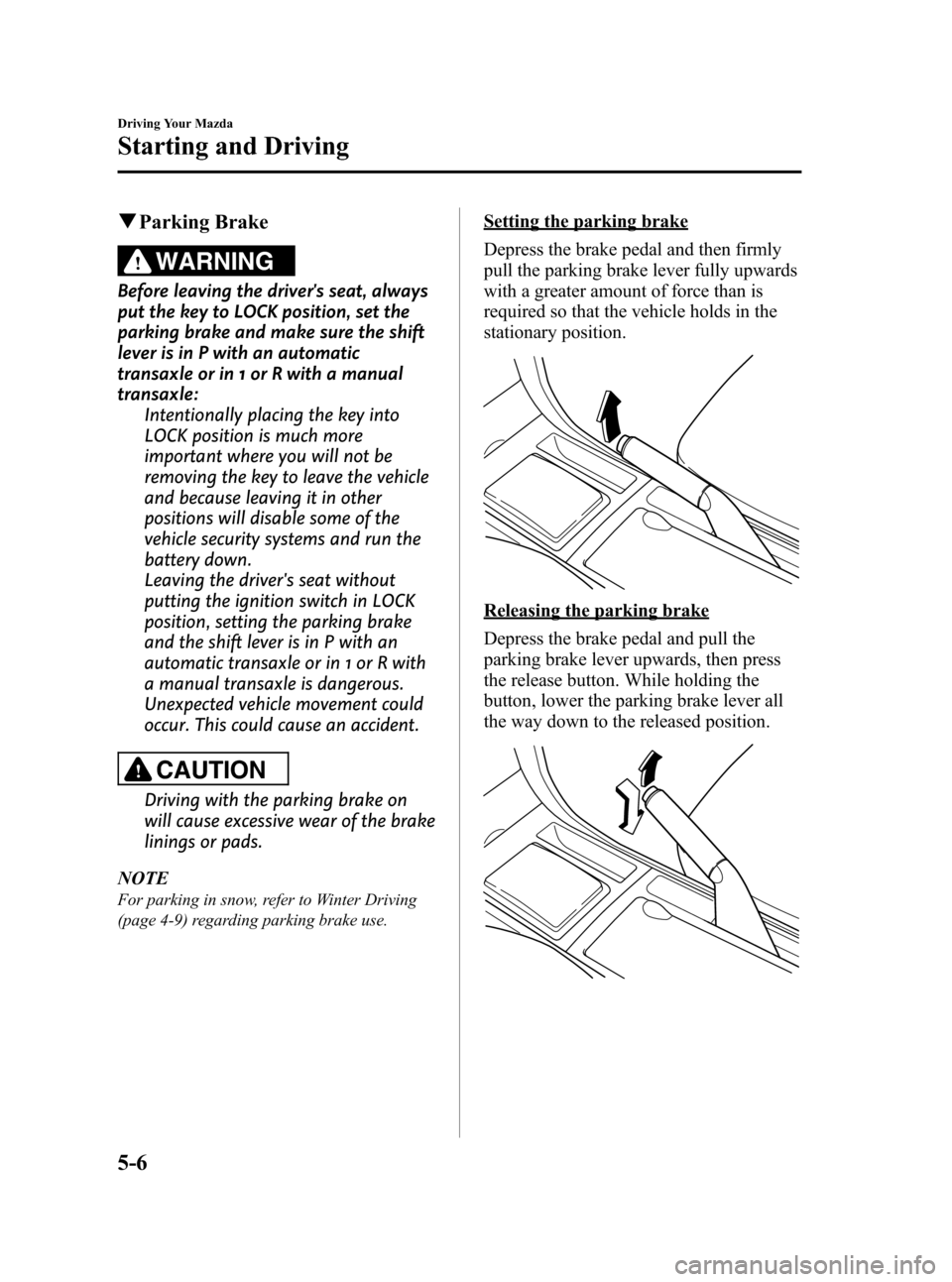
Black plate (124,1)
qParking Brake
WARNING
Before leaving the driver's seat, always
put the key to LOCK position, set the
parking brake and make sure the shift
lever is in P with an automatic
transaxle or in 1 or R with a manual
transaxle:
Intentionally placing the key into
LOCK position is much more
important where you will not be
removing the key to leave the vehicle
and because leaving it in other
positions will disable some of the
vehicle security systems and run the
battery down.
Leaving the driver's seat without
putting the ignition switch in LOCK
position, setting the parking brake
and the shift lever is in P with an
automatic transaxle or in 1 or R with
a manual transaxle is dangerous.
Unexpected vehicle movement could
occur. This could cause an accident.
CAUTION
Driving with the parking brake on
will cause excessive wear of the brake
linings or pads.
NOTE
For parking in snow, refer to Winter Driving
(page 4-9) regarding parking brake use.
Setting the parking brake
Depress the brake pedal and then firmly
pull the parking brake lever fully upwards
with a greater amount of force than is
required so that the vehicle holds in the
stationary position.
Releasing the parking brake
Depress the brake pedal and pull the
parking brake lever upwards, then press
the release button. While holding the
button, lower the parking brake lever all
the way down to the released position.
5-6
Driving Your Mazda
Starting and Driving
Mazda3_8X41-EA-07F_Edition2 Page124
Monday, June 18 2007 1:28 PM
Form No.8X41-EA-07F
Page 125 of 394
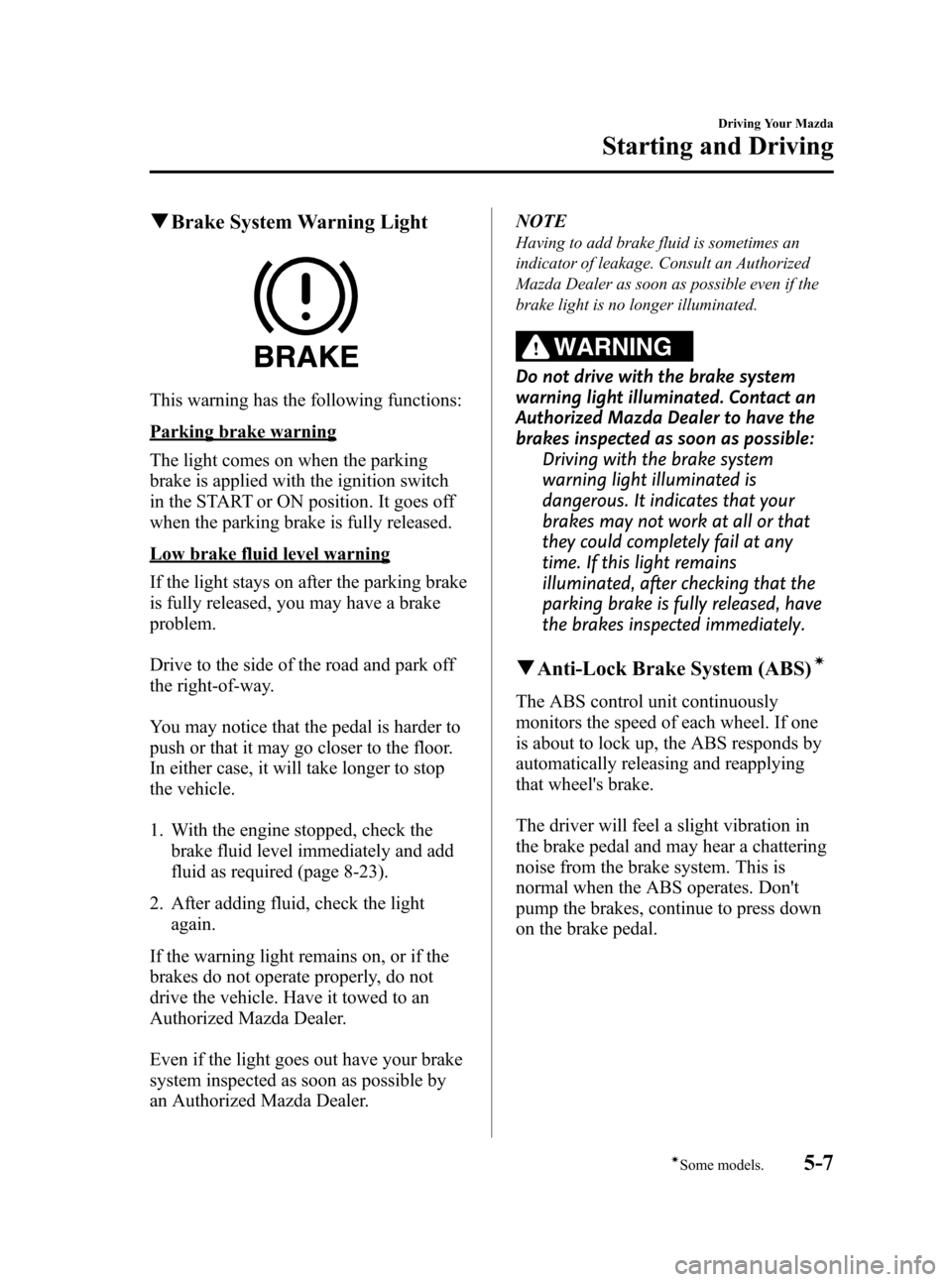
Black plate (125,1)
qBrake System Warning Light
This warning has the following functions:
Parking brake warning
The light comes on when the parking
brake is applied with the ignition switch
in the START or ON position. It goes off
when the parking brake is fully released.
Low brake fluid level warning
If the light stays on after the parking brake
is fully released, you may have a brake
problem.
Drive to the side of the road and park off
the right-of-way.
You may notice that the pedal is harder to
push or that it may go closer to the floor.
In either case, it will take longer to stop
the vehicle.
1. With the engine stopped, check the
brake fluid level immediately and add
fluid as required (page 8-23).
2. After adding fluid, check the light
again.
If the warning light remains on, or if the
brakes do not operate properly, do not
drive the vehicle. Have it towed to an
Authorized Mazda Dealer.
Even if the light goes out have your brake
system inspected as soon as possible by
an Authorized Mazda Dealer.NOTE
Having to add brake fluid is sometimes an
indicator of leakage. Consult an Authorized
Mazda Dealer as soon as possible even if the
brake light is no longer illuminated.
WARNING
Do not drive with the brake system
warning light illuminated. Contact an
Authorized Mazda Dealer to have the
brakes inspected as soon as possible:
Driving with the brake system
warning light illuminated is
dangerous. It indicates that your
brakes may not work at all or that
they could completely fail at any
time. If this light remains
illuminated, after checking that the
parking brake is fully released, have
the brakes inspected immediately.
qAnti-Lock Brake System (ABS)í
The ABS control unit continuously
monitors the speed of each wheel. If one
is about to lock up, the ABS responds by
automatically releasing and reapplying
that wheel's brake.
The driver will feel a slight vibration in
the brake pedal and may hear a chattering
noise from the brake system. This is
normal when the ABS operates. Don't
pump the brakes, continue to press down
on the brake pedal.
Driving Your Mazda
Starting and Driving
5-7íSome models. Mazda3_8X41-EA-07F_Edition2 Page125
Monday, June 18 2007 1:28 PM
Form No.8X41-EA-07F